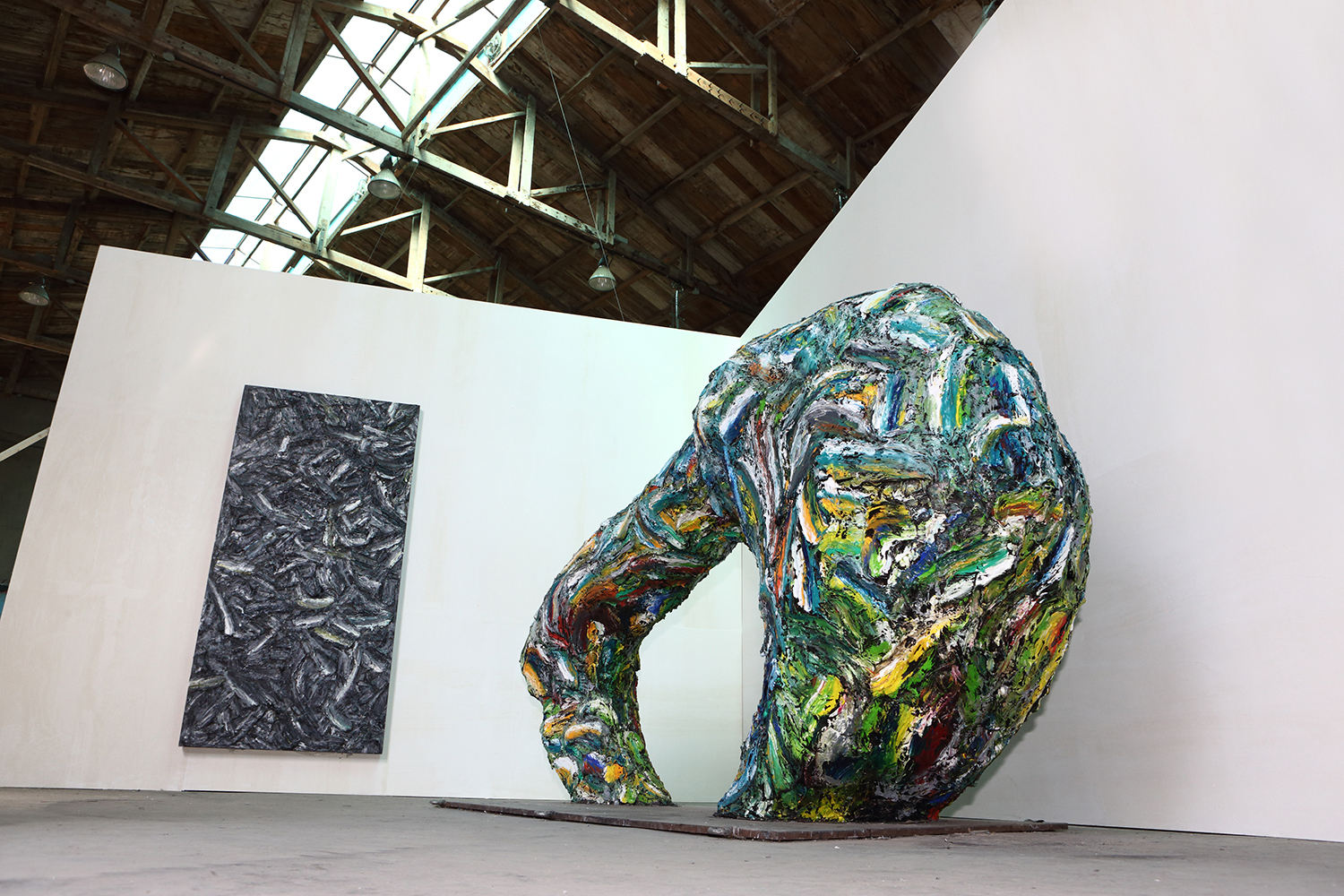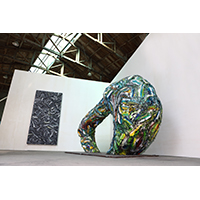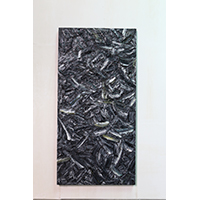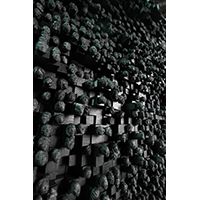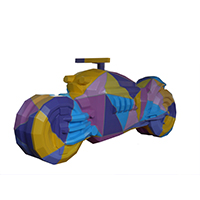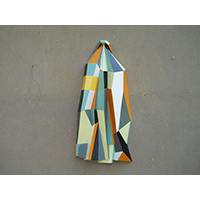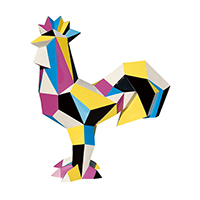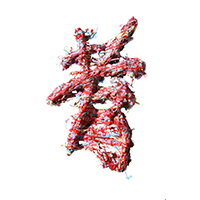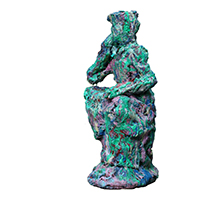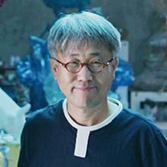
Yongmeon Kang, NAMPO Museum of Art
Birth
1957, Gimje, South-Korea
Genre
Sculpture, Installation
Homepage
A New Icon Created by Reviewing the Old and Learning the New
When it comes to our mind that the artist takes the initiative in debating about the topic of tradition, his statement of 'negation' and 'objection' may sound surprising, in a sense. It must, however, be taken into account that his argument begins always with 'reinterpretation and transformation of tradition', not with 'conservation and representation of tradition'. The reinterpretation in this context refers to the review of tradition on a new horizon instead of a customary and stereotyped way that has been applied so far to interpretation of tradition in strict compliance with the guidelines of its text. This may occur only when both the original position of the text and the current location of the context are reexamined and contemplated simultaneously. The reinterpretation of artistic creation, different from that of academic field, should then focus on laying foundation for the proper place of the text, requiring to consider the contextual situation with greater priority. Otherwise, the contemporary art will only remain to be the inherited handicraft which is simply involved in restoring itself to the original place. It can therefore be allowed for today's painters to do everything in connection with assembling or disassembling the tradition as a text in a subjective manner in line with the context and background of their creation 'Here, right now'.
Just as the primitive spirit of the contemporary art is the outcome of the free avant-garde movement, the goal of Kang, Yongmyeon's negation and objection does not deviate from the topic of reinterpretation and transformation of tradition but rather yields an extremely mutually effective and optimal common denominator. As his view of creation by 'reviewing the old and learning the new' used to interchange with the spirit of Yin-Yang and Five-Elements that are aimed at win-win strategy as well as at antipathy, negation and objection, together with harmony, might be key words for him to promote experimental art with. If, therefore, the status of his text awarded with tradition is translocated into his world of creation, it may be concluded that his text (created work), together with the context (history, tradition and contemporary socio-cultural phenomena and background), will continue to exchange ceaselessly not only the dimension of commensalism for harmonious life but also the dimension of antipathy (negation and objection as termed by him) by means of 'reinterpretation and transformation'.
At last, the extrapolation of his work would be connected not with 'tradition' but with 'transformation of tradition' while the interpolation of his work would become a continuum not of 'tradition' but of 'reinterpretation of tradition'. Some of examples in this regard include his reinterpretation of mutual communication between the interior (microcosmos) and exterior (macrocosm) by transforming pieces of the sturdy body of a funeral bier into colorful mosaics on the acrylic plate as well as reinterpretation of philosophy of vacancy by creating a space for reservation with the outer layer of a sculpture covered with a transparent acrylic color plate. The concept of 'space for reservation' reveals here, through reinterpretation of tradition, not only the traditional thoughts of existence, i.e. 'all is vanity', but also the contextual situation of the non-materialistic world at the time when digital technology plays a pivotal role. His recent formative experiments by means of high-tech media seem to witness his attempts to grow out of the traditional way of woodcraft carving and coloring the white pine, resulting from his incessant tries to communicate between the exterior called 'transformation of tradition' and the interior called 'reinterpretation of tradition'. The key to understanding his works fully will be something like the New Icon born from his creative aesthetics termed 'reinterpretation and transformation of tradition' by reviewing the old and learning the new. It is widely recognized that Kang, Yongmyeon's work is based on diverse traditional icons including folkloric elements like pieces of funeral bier aimed at soothing the souls of the dead at funeral rituals as well as folk paintings, stone images of literary men, etc. aimed at praying for happiness and kicking out of demons. Meanwhile, the New Icon, the destiny of his works (in my view), has not yet found its proper place as a whole in that it was originated from the experimental art that borders the traditional fine arts with the contemporary daily life. Although his works often feature such figures as Mickey Mouse in colors of 5 directions, B-boy and Gundam in a concrete shape, the painter is currently proceeding gradually with formation of his wholesome status by maintaining the pivot of transformation and generation he has been pursuing to fulfill.
Right on this day, as usual, he is passionately repeating his new 'experiments for transformation' to an unexpected extent at his colossal-sized studio which he remodelled from an abandoned warehouse in the vicinity of Gunsan City, transfiguring himself over and over again by creating moving from pausing, vacating from filling, and 3-dimension from 2-dimension. It may be too early to define the status of his New Icon now as it is still in progress for being shaped currently. It seems thus appropriate to put off another discussion about his New Icon in order to give him more time for further creative activities.
Kim, Seongho (Art Critic)
Operative Community sprouting on the base of Meta-Maninbo(meta-萬人譜) or universal harmony
Art of the public, aesthetics of universal harmony based on root awareness
Aesthetics of universal harmony based upon art of the public and root awareness is the language and concept propping up Gang, Yongmyeon's world. Even while his thinking crosses life and death, his sculpture does not turn its eye away from the topographic cries of the place where his life settles. He was so from his series in the 1990s to in the 2000s. is works depict the images around our life in the twists of time such as people dressed in colorful Hanbok, folklore characters, animals, patterns of wrapping cloth, bier flowers, copper rice bowl and the like. Plain-looking, warm expression melts in his not grandiose but bantering materials. This way, it's apparent that with the full power, he resists elitism of modernistic aesthetics rampant in this world, decadence of thinking & expression lying therein and thus his works are clearly different from those made by his contemporary sculptors.
Compared with his so-far formative art career, his tone of thinking and atmosphere streams through his works exhibited this time; the series of , , and look totally different from his previous ones. First of all, in his works this time, it's hard to find his public-friendly way of speaking typical of his artistic world, fancy colorfulness and folklorish familiarity, witty artcrafts, loosely spread composition & installation. He seems to have completely removed all those as if they were also a continuation & legacy of decadent aesthetics of fineness. Black monochrome in place of colorfulness, flows with an epic tension throughout his works. His previous witful merriness is conceptually replaced with the indicative mood. Plain beauty yields to serious beauty.
True as it may be, the context is not severed. His public living in year 2014 are more intensely equal and democratically consolidated than before. They all stand beyond the boundary of customs, norms and limitations given by each history, time, society and culture. Their identity is no longer defined by blood lineage, nationality, political status, social rank, personal accomplishment and so forth. Differing ethical beliefs or behavioral principles that might have ruled their life are no longer a meaningful basis. In this new world are neither heroes nor petty commoners. Appropriateness telling nobler figures, bigger values from relatively smaller ones, basis on which to separate the public's applause from anonymity, and stage bisecting performers and the audience don't work anymore. All share an equal status, equal authority and equal right to speech.
His public, gathering in that manner, form a structure with the majesty of well-forged universal harmony and a vast order, where individuals are connected to one another to run after a community, which becomes a soma of universal harmony, that is, an expressed ideal of a universally harmonized nation bestowing an integrated context to its individuals. According to Seneca, for fractured individuals to be born anew into an integrated body, there has to be the mind letting such a thing exist. And for him, it is imperial governance. Then, what is the substantial power subliming people to a solidly-built soma of universal harmony and accomplishing its inner integration that crosses through each one's individuation? We are impressed by the possibility of unexpectedly finding an answer to this question long existing in civilization history in the manner his formative art builds itself.
At least from the early 2000s, he selected a method to go towards a bigger mass by accumulating, conglomerating or combining little fragments. After this period, his sculpture would look like structures made of small pieces. An entirety would get sculpted by carving, moulding and assembling tens of, hundreds of wood pieces elaborately painted in various types. At times, each sculpture is placed either on walls or the floor in loose, sparse and regular pattern, by which the sculptor explores post-modernistic 'open sculpture' or the possibility of 'anti-sculpture.'
However, the terminologies such as open sculpture or post-modernistic sculpture merely project a formalistic view in themselves. What is vital in his world is the fact that each unit objet forms a universally harmonized soma through various types of combination. Small things combine to be an entirety and the entirety respects each objet's autonomy, where parts are the entirety and individuation is of communal nature and finally the public become a universally harmonized soma. The entirety does not belittle parts and the soma does not disregard the public. People march towards a bigger undivided world while they coexist and communicate with one another.
As if all are connected by a nerve net, the process for each member to secure its communal nature is a sublime re-demonstration of a process exploring the possibility of human community in which everyone can live and thrive together. Upon an ideal that the reason born in the Enlightenment Era can hardly dream of, upon a true vision of universal harmony that humans have endlessly dreamt of at least since the French Revolution, Mr. Gang, therefore, bestows a strong expression. Though he does not write an aesthetic declaration nor call for his comrades, he stands closer to the public than anyone else. He must be a sculptor wholeheartedly listening to what they want. Therefore, his monochrome world is interpreted as having more inner colorfulness, his black becomes a color insinuating a living world and his silence comes to us as louder cries.
An operative community or Meta-Maninbo
‘A community is of danger.’ This has continually been confirmed by the western intelligentsia. because they saw all types of political forces vie to bind the public to false concepts of identicalness called community to subdue people 'only’ under a myth or ideology. Jean Luc Nancy says, "And the constant problem is the age of loss where a community gets organized close, harmonious and unbreakable, where the community is given certain expressions by institutes, concepts and symbols, and where people makes a living dedication to singleness, intimacy and internal autonomy." Because communities were so many times misused in an effort to hastily categorize their existents as a soma, and with almost no exception, brought about the political stress of despotism, the term of community among the western intellectuals has been almost a tabooed topic.
Actually, no living, organic community has been found in the western hemisphere since the modern time. Loss or existential severance of community is found in all the processes today. Throughout the modern time, the west could not get out of a state where it could hardly walk, caught in a terrible snare called individualism. The reason for such an inevitable failure, says Jean Luc Nancy, was the loss of internal substantiality uniting members of a community. The main culprit for that situation is, of course, the modern time's selfish individualism. He says that individualism is a far-fetched wordplay derived of individualistic concepts of self-conflict in oblivion of the fact that individual issues are global at the same time.
According to him, in dramatic worries over what verbally gives many existents common phenomena, that is, what 'beings of singularity' are deprived of by Marxism and Nazism, another myth caught in the snare of independence is formed and it is called individualism. And in the malfunctioning individualism, generalized equalization infinitely expands to what they call western capitalism. Think how miserable victims the doers become in a frantic consumption wind blowing around smart phones. The public's soul dismembered into terminalized privates are completely addicted to exclusive media and commercials.
In this light, an answer to how alternatives to dismemberment of the western capitalism is not so vague. It is to recovery communal nature, yet with measures blocking the return to deceptive totalitarianism, that is, to come forward to 'Nancy-conceived community.' Inoperation means 'a behavior producing nothing yet transforming its doers.' For one thing, inoperation is an imaginary behavior allowing constantly changing, endlessly appearing, imperfect doers to sustain their being in an appropriate state, that is, to keep them from falling in the snare of childish independence to guarantee relations revertible to the society or relations untamable to the society. Because only then will a direction to resisting capitalism & values of neo-capitalism, or non-social unequivalent society be possible.
Though 'Imagining Inoperative Community' suggested by Nancy falls back to part of totalitarianism and provides childish consumers(booty of capitalism) with meaningful awakening, it's doubtful if it could lead the human race or, at least the west to a better place than now. Because in the inoperation enabling inoperative community lies self-contradiction bringing even the vision back to inoperation. To escape from today's miserable privatopia(a fallen utopia of individualism) that Nancy himself is already aware of, active doers with ethical discernment and activism are more necessary than imperfect doers, and 'the operative community' encouraging not a passive state but humble enthusiasm and aggressive activism has to settle in as a vision.
We know what Nancy is concerned about. Because we know it, we can't help agreeing to the fact what we see Mr. Gang's world overflowing with a possibility in relation to this topic. Could we have this epic soma of universal harmony suggested by Gang, Nancy's concern might prove undue. In this soma, people are more than individualistic and equal, communicate and cooperate with one another in clear singularity. None of them is victimized by the whole, nor childish easy to be hypnotized. Though they all lived or may live in mutually different times with differing roles, they are of a joyful family at this moment in this soma. Here, they are members of a great community, an identical history of sublimity.
One day, Martin Luther said, 'One is kind of salvation to the other.' His word seems to be also applicable to Gang's world, in which people seem to bind one another with sort of truth. One seemingly is a rabbi, a priest and a teacher to the other. For this reason, his hopeful expectation for a universally harmonized soma soon settles in our heart, the expectation that the soma will not malfunction as our communities have always been.
One is a human and a world only when one is placed among humans.
Sim, Sangyong(Ph. D. in art history, Dogduk Woman University)






